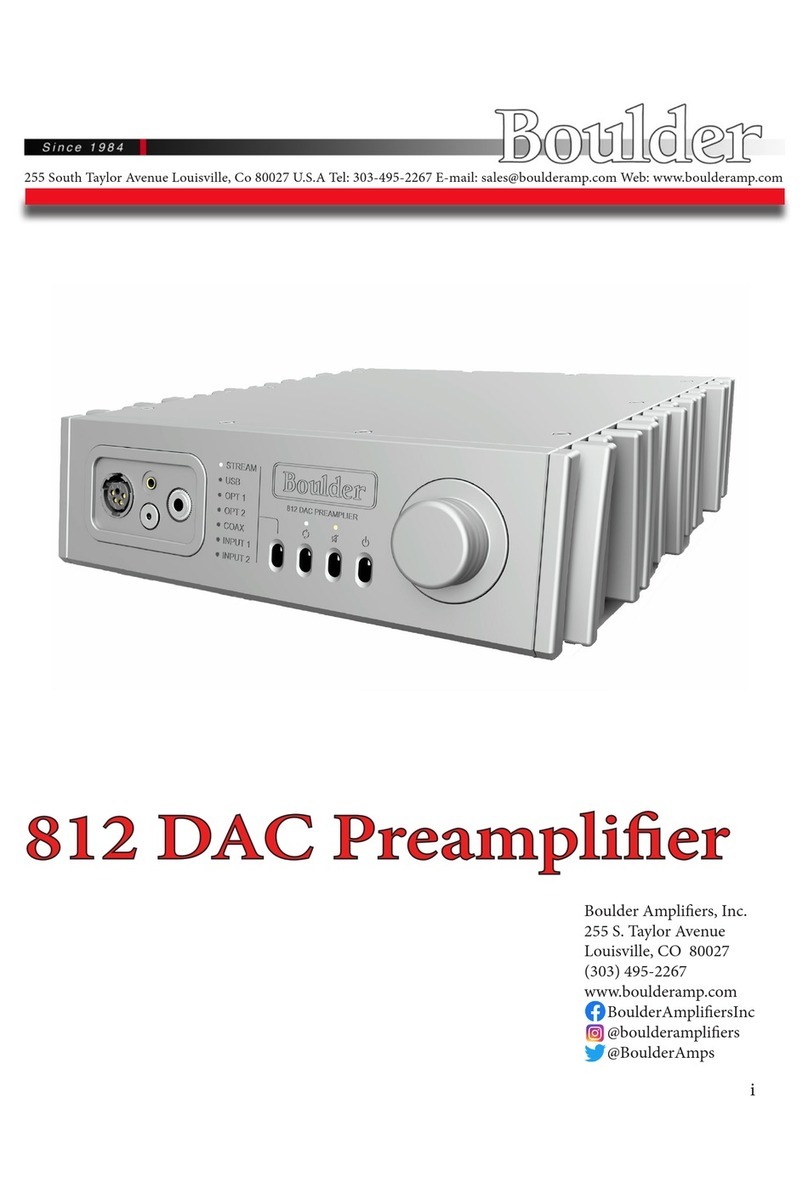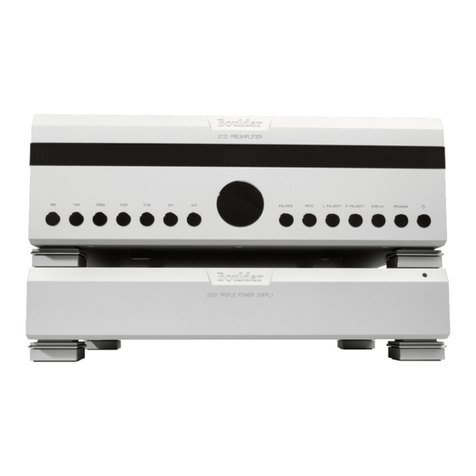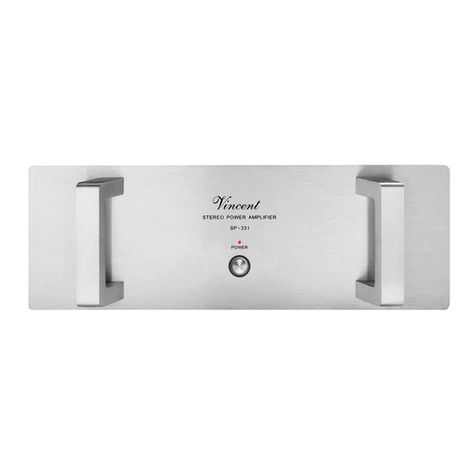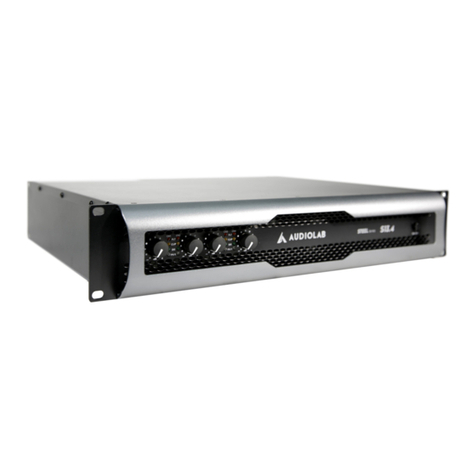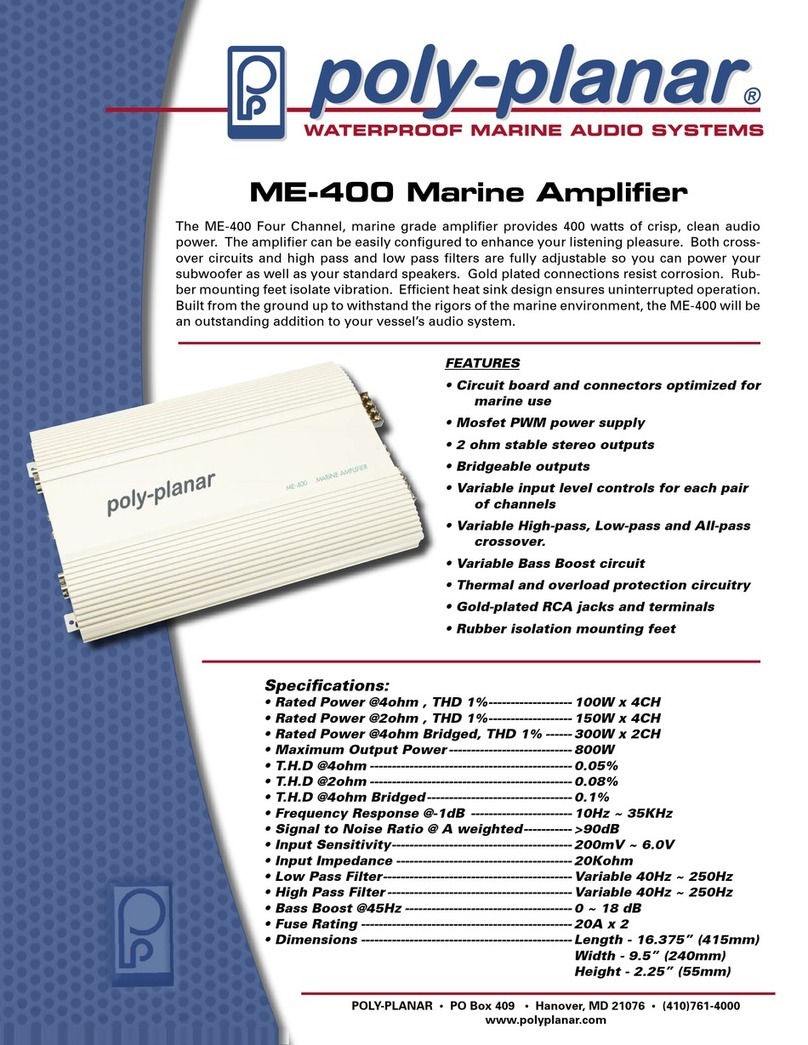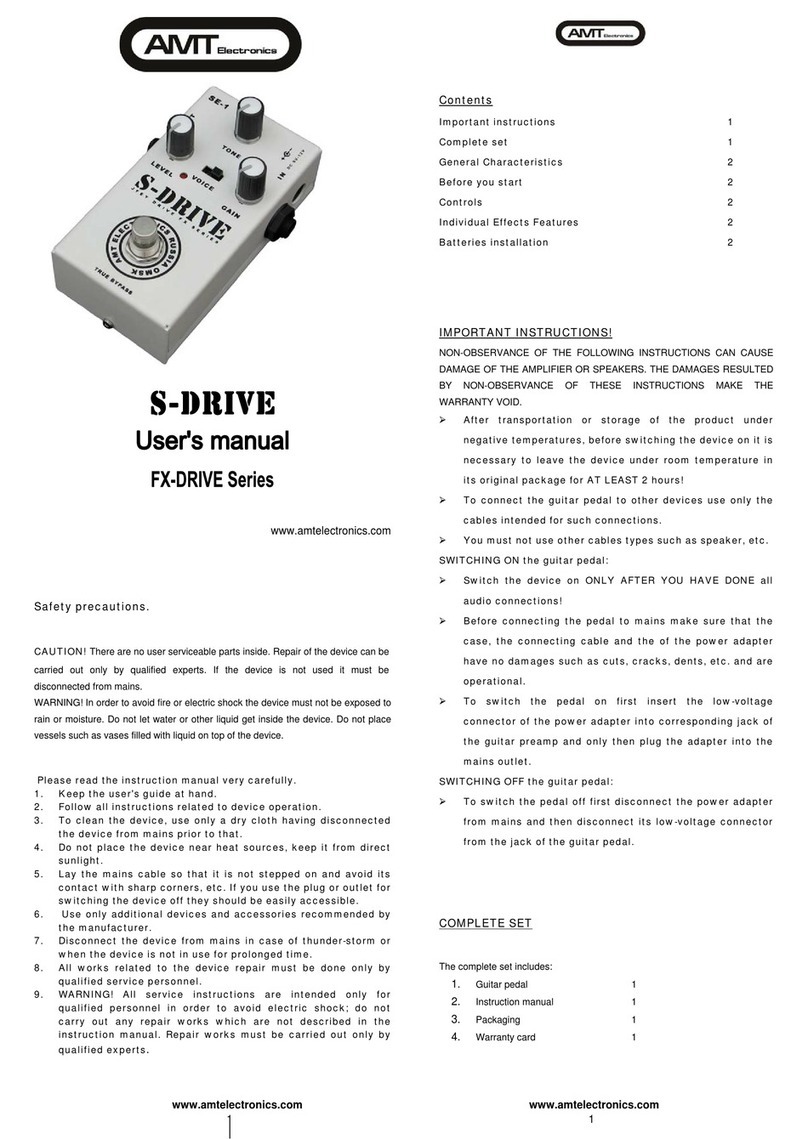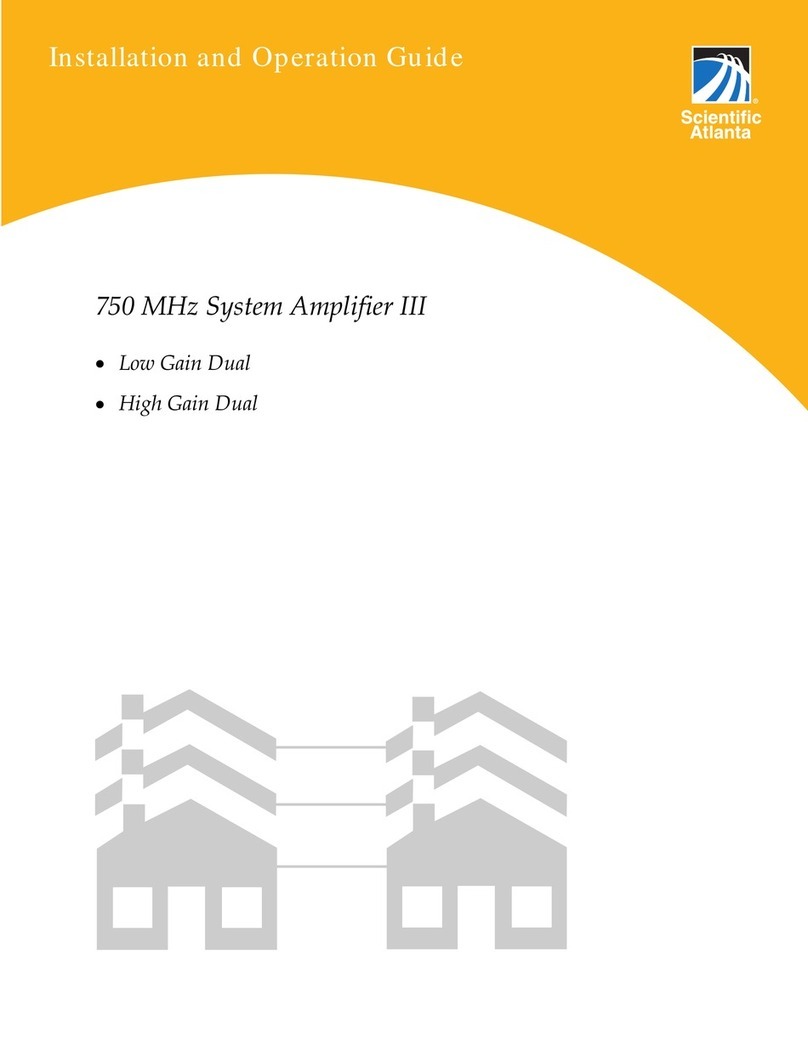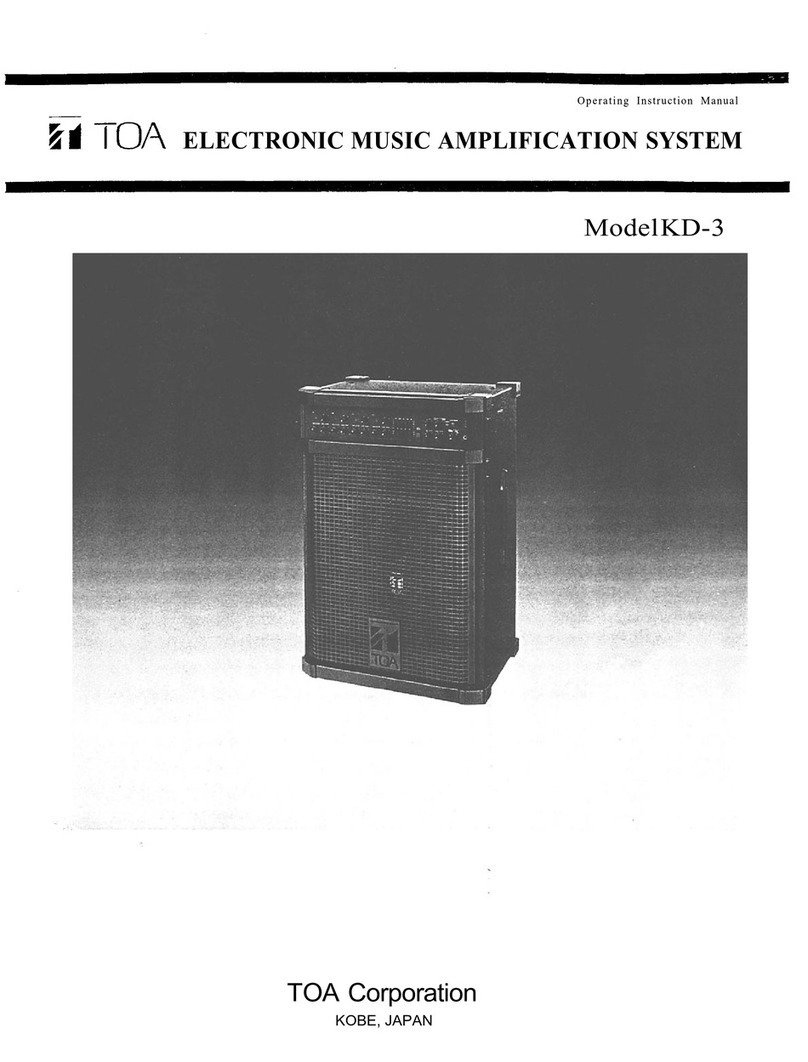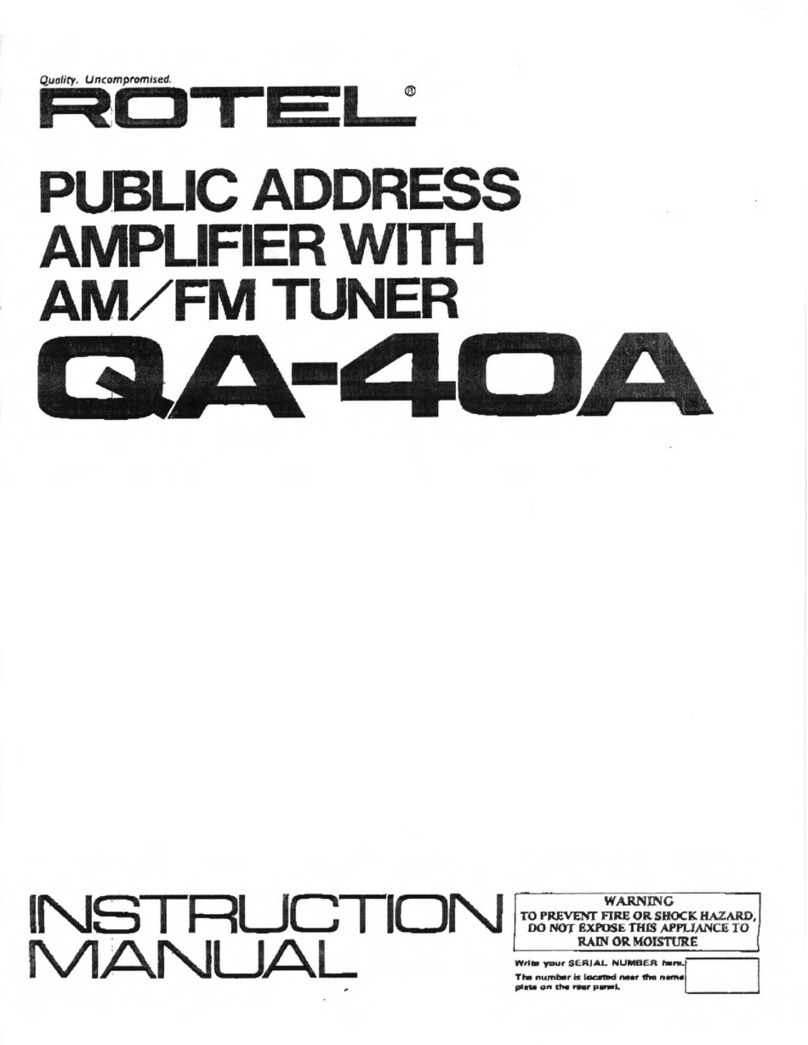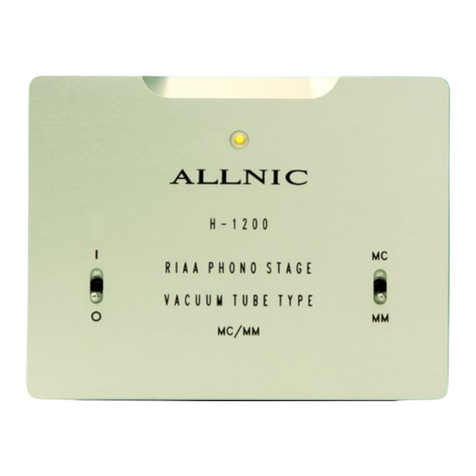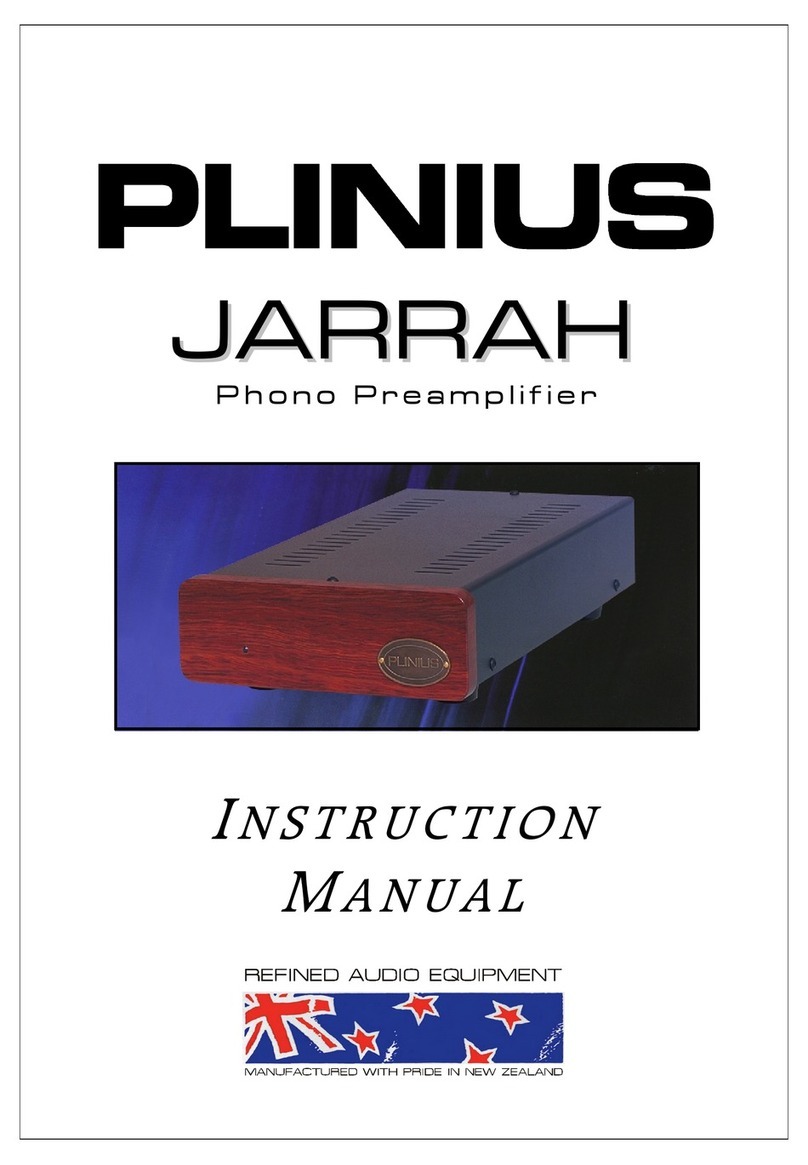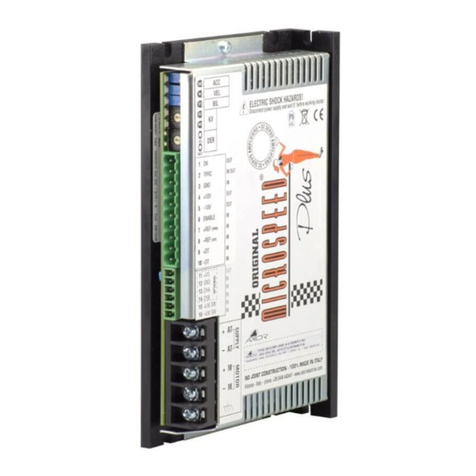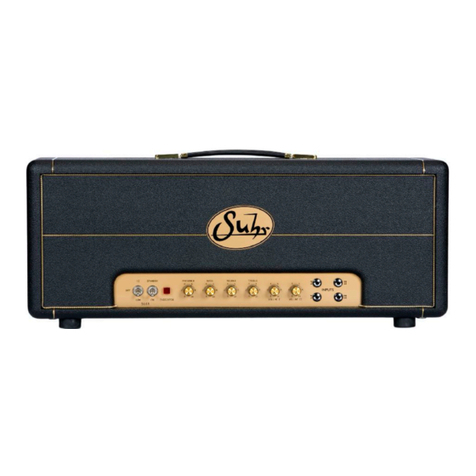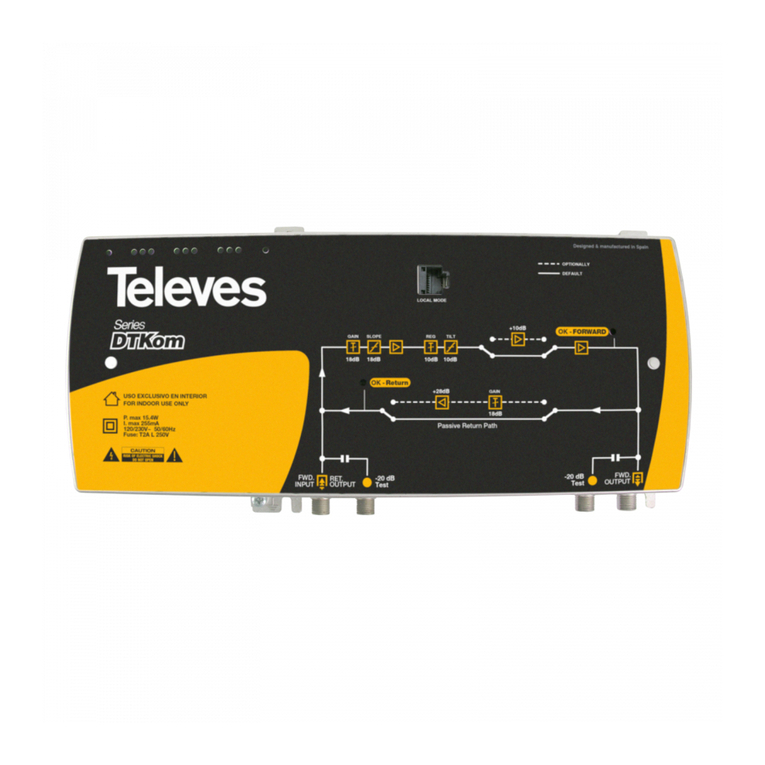Boulder 1160 User manual

1160 Stereo Power Amplier
Boulder Ampliers, Inc.
255 S. Taylor Ave.
Louisville, CO 80027
(303) 449-8220
www.boulderamp.com
03/01/2018
Rev. 1.0
P/N: 91055

About
About Boulder Ampliers, Inc.
Boulder was founded in 1984 and is the last high-performance audio
manufacturer operating in North America to still perform all of its own
design, engineering and manufacturing in-house. While this form of
production may be more costly than outsourcing, the resulting quality
control and reliability of the nished products are never compromised.
In 2016, Boulder moved into a new, purpose-built production facility to
increase manufacturing efciency and offer space for expansion to meet
the needs of future growth.

Thank You
Congratulations and thank you for selecting the Boulder 1160 Stereo
Power Amplier for your high-performance sound system. We are certain it
will provide you with many years of listening pleasure.
The 1160 represents the concerted efforts of numerous Boulder designers,
engineers, and technicians working to bring you the best audio playback
components in the world. This amplier is among the best that Boulder has
to offer.
Please take a few minutes to read through this instruction manual prior
to using your 1160. This will help you understand the many functions
and capabilities of the amplier. It will also allow you to maximize the
exceptional performance for which it was designed.
Your Boulder 1160 Stereo Power Amplier has undergone extensive
laboratory tests for safety, functionality, and technical excellence. In
addition, it has been individually subjected to rigorous listening trials in
our sound room utilizing a wide range of musical material. No product
ever leaves our factory until we are totally satised that it achieves its full
potential.

Table of Contents
Getting Started
Placement of the 1160 Stereo Power Amplier •••••••••••••••••••••••••••1-1
Connecting to the AC Mains Outlet •••••••••••••••••••••••••••••••••••••1-1
Connecting to a Network ••••••••••••••••••••••••••••••••••••••••••••••1-3
Connecting to a Balanced Source •••••••••••••••••••••••••••••••••••••• 1-3
Connecting to an Unbalanced Source •••••••••••••••••••••••••••••••••••1-3
Polarity •••••••••••••••••••••••••••••••••••••••••••••••••••••••••••••1-5
Connecting Your Loudspeakers ••••••••••••••••••••••••••••••••••••••••1-5
Operation
Powering Up ••••••••••••••••••••••••••••••••••••••••••••••••••••••••2-1
Input DC Offset Voltage Detection ••••••••••••••••••••••••••••••••••••••2-3
Clip Detection •••••••••••••••••••••••••••••••••••••••••••••••••••••••2-3
Thermal Protection •••••••••••••••••••••••••••••••••••••••••••••••••••2-3
Maintenence ••••••••••••••••••••••••••••••••••••••••••••••••••••••••2-4
Remote Control
Remote Operation•••••••••••••••••••••••••••••••••••••••••••••••••••• 3-1
Fault Conditions
Errors Requiring Boulder Dealer Service ••••••••••••••••••••••••••••••••4-1
Operational Errors •••••••••••••••••••••••••••••••••••••••••••••••••••4-1
Appendix
Specications •••••••••••••••••••••••••••••••••••••••••••••••••••••••6-1
Weights & Dimensions ••••••••••••••••••••••••••••••••••••••••••••••••6-2
Troubleshooting•••••••••••••••••••••••••••••••••••••••••••••••••••••• 6-3
Notes•••••••••••••••••••••••••••••••••••••••••••••••••••••••••••••••6-4


1-1
Getting Started
Getting Started
Placement of the 1160 Stereo Power Amplier
Your Boulder 1160 Stereo Power Amplier is designed to reduce
interference from external magnetic and radio elds (RF). While placement
is not critical, known magnetic elds should be avoided.
Moving this component will require at least four people, as it is very heavy.
Professional movers are recommended.
The 1160 Stereo Power Amplier will generate some heat. Therefore,
it should be located in an area with ample air circulation. Specically,
be certain that the heat sinks are unobstructed by objects that could
potentially block airow. Do not place the amplier on deep carpet and be
sure that the amplier has a minimum of 3 inches (8 cm) of free airspace
on all sides.
You may want to have access to the rear panel for cable changes.
Although input cables can be as long as necessary, it is suggested that
speaker cables be as short as possible.
Connecting to the AC Mains Outlet
Your 1160 Stereo Power Amplier is supplied with a mains power cable
suitable for the location where it was purchased. It is constructed of large
enough wire gauge and a plug appropriate for your AC line voltage. Do not
substitute another power cable.
Exact voltage and frequency compatibility is stated in the specications
section. See page 6-1.
Once the 1160 Stereo Power Amplier is connected to a live mains outlet
and the rear panel switch is moved to the “On” position, the LED on the
front panel will illuminate red for a short time. During this time the 1160 is
booting up.
The LED will then pulse white on and off, indicating that the supervising
microprocessor is powered up and the amp is ready to be turned on.

1-2
Getting Started
Getting Started

1-3
Getting Started
Getting Started
Connecting to a Network
In order for the 1160 to download software updates as necessary, it will
need to be connected to a network with an active Internet connection.
Connect a network cable between the 1160 and a network router or switch.
Use either Ethernet connector on the rear panel of the 1160; it does not
matter which one you use.
Connecting to a Balanced Source
To fully realize the sonic potential of your 1160 Stereo Power Amplier,
always use balanced connections. Balanced cables minimize interference
from magnetic and RF sources.
Connect the cables from your source or preamplier outputs to the input
connections provided on the rear panel of the 1160.
Connecting to an Unbalanced Source
Although the inputs are of the 3-pin XLR-type, an unbalanced source is
easily accommodated by using a special cable. This cable has an RCA-
type connector on the source end and a 3-pin XLR connector on the 1160
Stereo Power Amplier end.
The negative input (pin 3) should be wired to ground only at the RCA
connector. This brings the negative input reference of the 1160 to the
unbalanced source ground, thus reducing loops.
Another option for accommodating unbalanced sources is the Boulder
ABL2 Input Adapter. It converts a balanced input into an unbalanced RCA
input at the rear panel of the 1160. Like the above cable, the negative input
of the 1160 is connected to the ground of the RCA connector. However, the
negative side will then share the shield wire with the chassis ground and
will not have very good hum rejection.
Please contact your authorized Boulder dealer for further information about
the ABL2 Input Adaptor.

1-4
Getting Started
Getting Started
Connecting to a Network
In order for the 1160 to download software updates as necessary, it will
need to be connected to a network with an active Internet connection.
Connect a network cable between the 1160 and a network router or switch.
Use either Ethernet connector on the rear panel of the 1160; it does not
matter which one you use.
Connecting to a Balanced Source
To fully realize the sonic potential of your 1160 Stereo Power Amplier,
always use balanced connections. Balanced cables minimize interference
from magnetic and RF sources.
Connect the cables from your source or preamplier outputs to the input
connections provided on the rear panel of the 1160.
Connecting to an Unbalanced Source
Although the inputs are of the 3-pin XLR-type, an unbalanced source is
easily accommodated by using a special cable. This cable has an RCA-
type connector on the source end and a 3-pin XLR connector on the 1160
Stereo Power Amplier end.
The negative input (pin 3) should be wired to ground only at the RCA
connector. This brings the negative input reference of the 1160 to the
unbalanced source ground, thus reducing loops.
Another option for accommodating unbalanced sources is the Boulder
ABL2 Input Adapter. It converts a balanced input into an unbalanced RCA
input at the rear panel of the 1160. Like the above cable, the negative input
of the 1160 is connected to the ground of the RCA connector. However, the
negative side will then share the shield wire with the chassis ground and
will not have very good hum rejection.
Please contact your authorized Boulder dealer for further information about
the ABL2 Input Adaptor.
EthernetInput Input

1-5
Getting Started
Getting Started
Polarity
Please note that the 1160 Stereo Power Amplier conforms to the AES
standard of pin 2 as the “high,” “positive,” or “hot” pin for the balanced
input.
The polarity of the 1160 Stereo Power Amplier is such that a positive-
going transition at pin 2 will produce a positive-going transition at the “+”
output terminal.
Connecting Your Loudspeakers
Do not use a wrench or any other type of tool on the output terminal
binding posts. Tighten these connectors by hand only.
WARNING: This is a high-powered amplier! There is high voltage
potential at the terminals when driven. Connections should only be made
with the AC mains disconnected!
Select speaker cable spade terminals that will accept .250-inch (6 mm)
diameter binding posts. Two sets of output connections are provided on the
1160 to enable easy bi-wiring. Because the binding posts are connected in
parallel for each channel, there is no advantage of one set over the other.
There is no provision for the use of banana plugs. Banana plugs are
proven to lose spring tension and come loose over time, increasing contact
resistance and distortion. We also do not recommend the use of banana
plugs at the speaker end for these reasons.

1-6
Getting Started
Getting Started

2-1
Operation
Operation
Powering Up
With all connections made, you are ready to listen to your Boulder 1160
Stereo Power Amplier.
To turn the amplier on, slide the rear panel Master AC Switch to the ON
position. The amplier will go through a turn-on sequence, during which
time the power LED will illuminate red.
The LED will then slowly pulse white on and off, indicating that the
supervising microprocessor is powered up. At this time, press the front
panel button to bring the unit out of Standby mode.
Because of the large inrush currents associated with the two large toroidal
transformers, four power relays are used to turn on the amplier. These
are under control of the supervising ARM processor. During the power up
sequence, you will hear two sets of two relay clicks, separated by intervals
of two seconds.
Once powered up, the front panel LED will steadily glow white to indicate
normal operation.
To turn the amplier off, press the Standby button again. The indicator
will then slowly and continuously change from white, to dark, and back to
white. This indicates that the amplier is in Standby mode.
NOTE: Because the 1160 greatly reduces power consumption when in
Standby mode, it is only necessary to place the amplier in Standby when
not in use. You do not need to turn the 1160 off via the Master AC Switch
on the rear panel. The 1160 was designed for years of operation in this
manner and no damage to the unit will occur.
Power Off Power On

2-2
Operation
Operation

2-3
Operation
Operation
Input DC Offset Voltage Detection
The Boulder 1160 is a direct-coupled power amplier with a servo for
zeroing out any DC voltage offset coming from the preamplier or other
sources connected to the amplier’s input.
If the DC at the inputs is sufcient to cause three volts or more at the
output terminals, a protection circuit will mute the amplier’s output by
electronically disconnecting the loudspeakers. The front panel LED
will also turn red. This condition will continue until the source of DC is
corrected or removed.
If the indicator remains red, it is recommended that the user correct the
DC offset of the source device before continuing.
Clip Detection
Clipping of the waveform results when any amplier is driven at too high a
level. A clip detection circuit is included in the 1160 Stereo Power Amplier.
The front panel LED will indicate clipping by momentarily turning from
white to red. Both voltage and current modes of clipping are detected,
although it is generally only voltage clipping that occurs.
Thermal Protection
A thermal protection circuit prevents high operating temperatures that are
unpleasant to the touch and potentially harmful to the amplier. A thermal
cutout circuit will mute the amplier when the transistor cases reach 85°C,
and the front panel LED will turn red. If this happens, the output level of
the system should be reduced and more ventilation should be provided for
the amplier.

2-4
Operation
Operation
Maintenance
No routine maintenance is required for the 1160 Stereo Power Amplier.
However, to keep operating temperatures at a minimum, be sure that the
heat sink ns are not obstructed and remove any dust buildup that may
occur.

3-1
Remote Control
Remote Control
Remote Operation
Remote control and operation of the Boulder 1160 Stereo Power Amplier
is possible by the use of a 12V trigger, an external IP control system, or
Boulder Net.
12V Trigger
The 1160 has a 1/8” minijack input connection on the rear panel for 12V
triggering that will allow it to be turned On or Off. To complete the 12V
trigger system, a single cable must be connected between the 1160 and
a source component or preamplier with a 12V trigger output connection.
The 1160 supports both continuous and toggle 12V trigger commands.
External IP Control Systems
Modern home integration and automation systems are generally controlled
through a home LAN (Local Area Network) via the use of IP (Internet
Protocol) commands. When connected to a LAN, the 1160 is able to
receive and respond to these commands through its Ethernet connection
on the rear panel.
For further information about IP control and automation systems, please
contact your authorized Boulder dealer.
Boulder Net
Boulder has developed an IP control system that is Open Home compliant
and unique to Boulder products. When multiple Boulder products are all
connected to a LAN, the Boulder Net system will allow you to turn various
products on or off and control the functions of all connected components
via an application that is downloadable to a mobile tablet or phone. Status
messages can also be passed to Boulder products with a display.
For further information about Boulder Net, please see the Boulder Net
Manual or visit www.boulderamp.com.

3-2
Remote Control
Remote Control

4-1
Fault Conditions
Fault Conditions
Errors Requiring Boulder Dealer Service
If the 1160 Stereo Power Amplier will not turn on and the front panel LED
blinks red, an error requiring dealer service has occurred. The indicator
may ash red in a specic sequence to dene its error code for an
authorized Boulder technician.
If you are experiencing this problem with your 1160, contact your Boulder
dealer immediately.
Operational Errors
At times the 1160’s front panel LED may ash red but continue operating
normally. This is an Operational Error and indicates that there is a fault
somewhere else in the system or in the use of the amplier. Conditions that
will be indicated as Operational Errors may include:
• DC offset at the input of the amplier (from a source or preamplier)
• Thermal limit or safe operating temperature of the amplier exceeded
• Clipping of the output signal

4-2
Fault Conditions
Fault Conditions

6-1
Appendix
Appendix
Specications
Continuous Power, Each Channel
Watts Ω THD 20-2kHz THD 20kHz
300 80.0008% 0.0040%
300 40.0012% 0.0065%
300 20.0018% 0.0100%
Peak Power, Each Channel
Watts Ω
300 8
600 4
1200 2
Equivalent Input Noise (EIN), 20kHz BW 1.5 µV
Magnitude Response, 20 to 20KHz +0.00, -0.04 dB
Magnitude Response, -3dB at 0.015Hz, 200kHz
Voltage Gain 26dB
Input Impedance Balanced: 200kΩ,
Unbalanced 100kΩ
Common Mode Rejection (Balanced only) 60 Hz: 90dB,
10kHz: 70dB
Inputs 3-pin Balanced
Output Connectors 2 sets of 6 mm / .250 inch wingscrews
Power Requirements 100, 110-120, & 220-240 VAC
50-60 Hz, 250W nominal, 5000 W at maximum output
*All specications taken at 240 VAC mains Power
Table of contents
Other Boulder Amplifier manuals
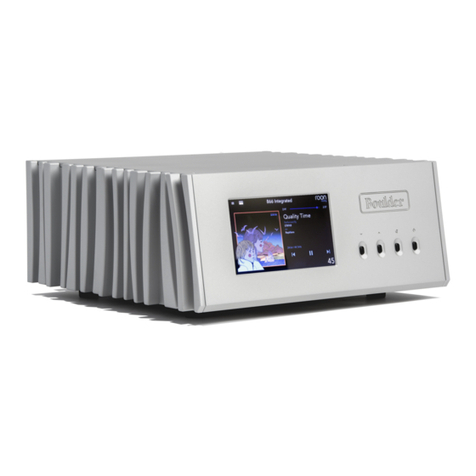
Boulder
Boulder 866 Analog User manual
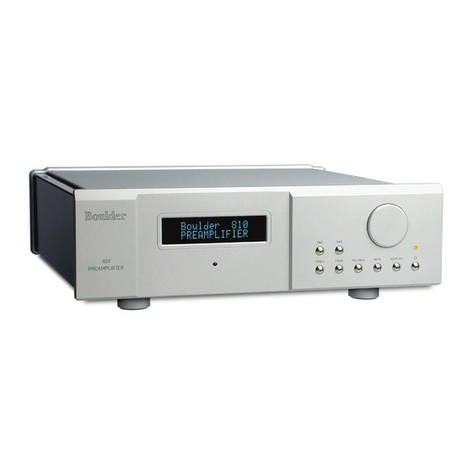
Boulder
Boulder 810 User manual
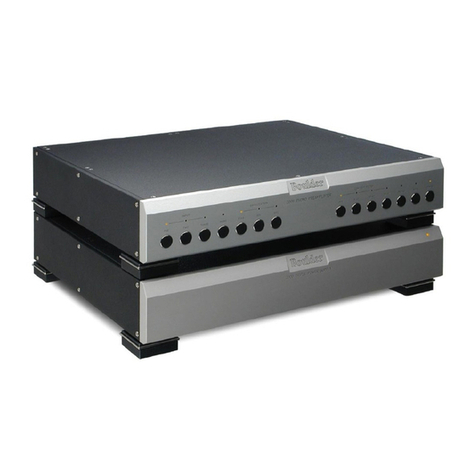
Boulder
Boulder 2008 User manual
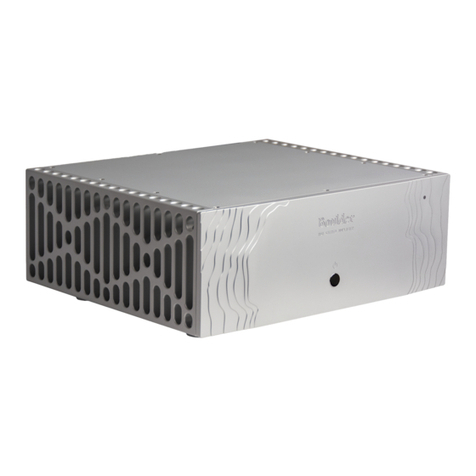
Boulder
Boulder 1161 User manual
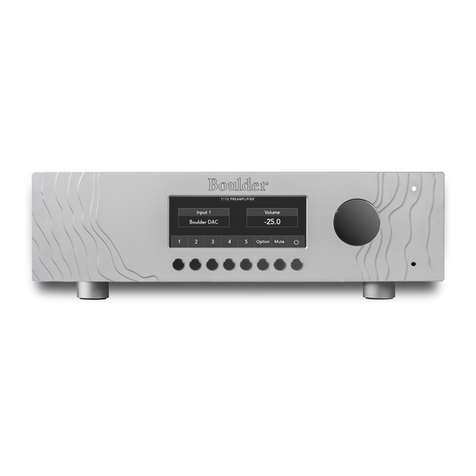
Boulder
Boulder 1110 User manual
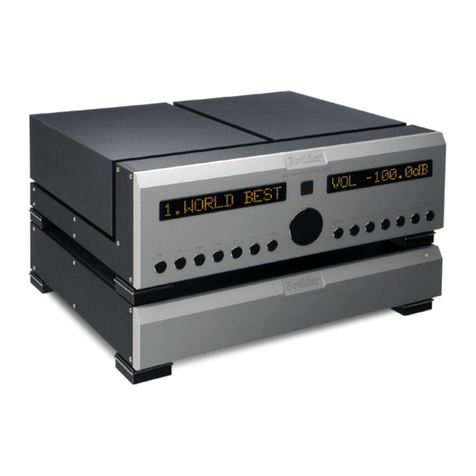
Boulder
Boulder 2010 User manual

Boulder
Boulder 2010 User manual
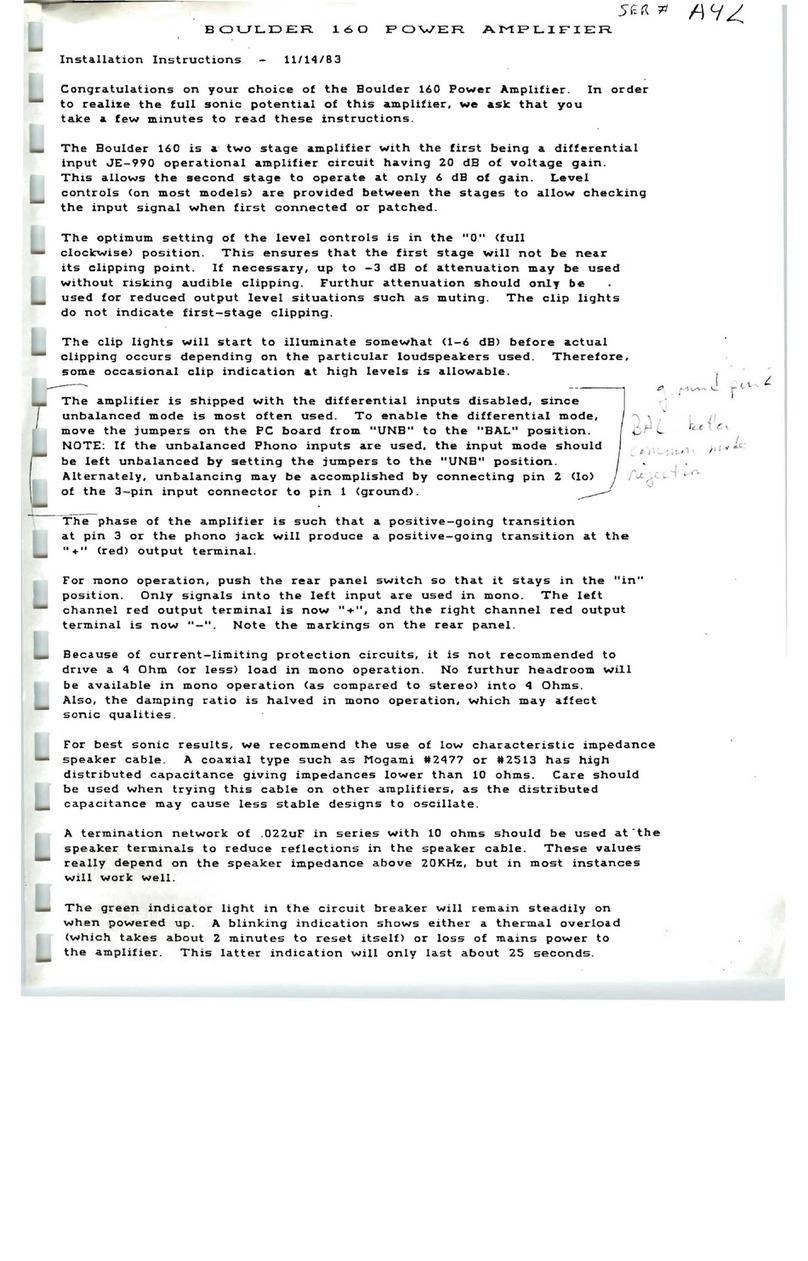
Boulder
Boulder 160 User manual
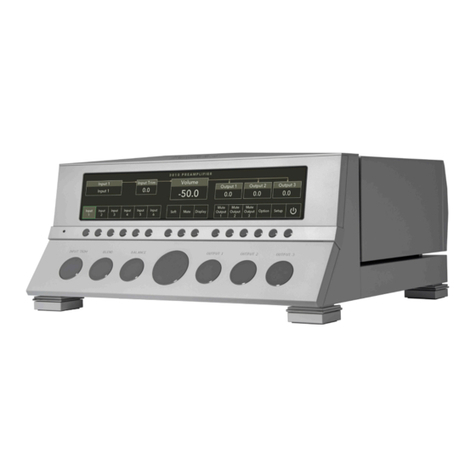
Boulder
Boulder 3010 User manual
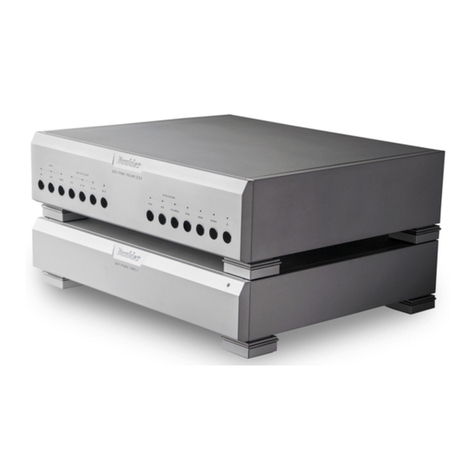
Boulder
Boulder 2108 User manual
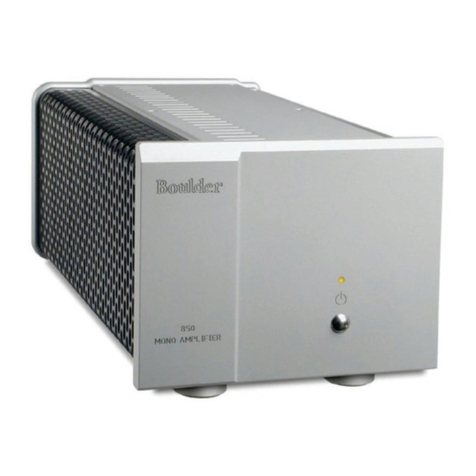
Boulder
Boulder 850 User manual

Boulder
Boulder 3050 User manual
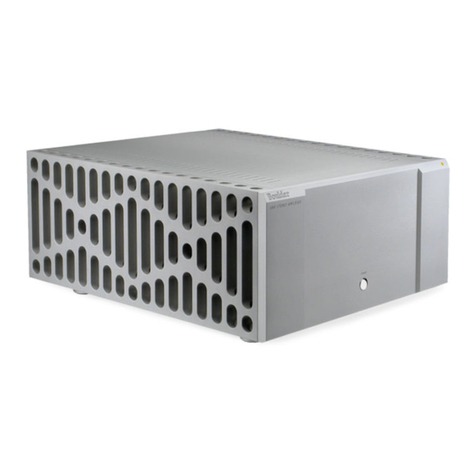
Boulder
Boulder 1060 User manual
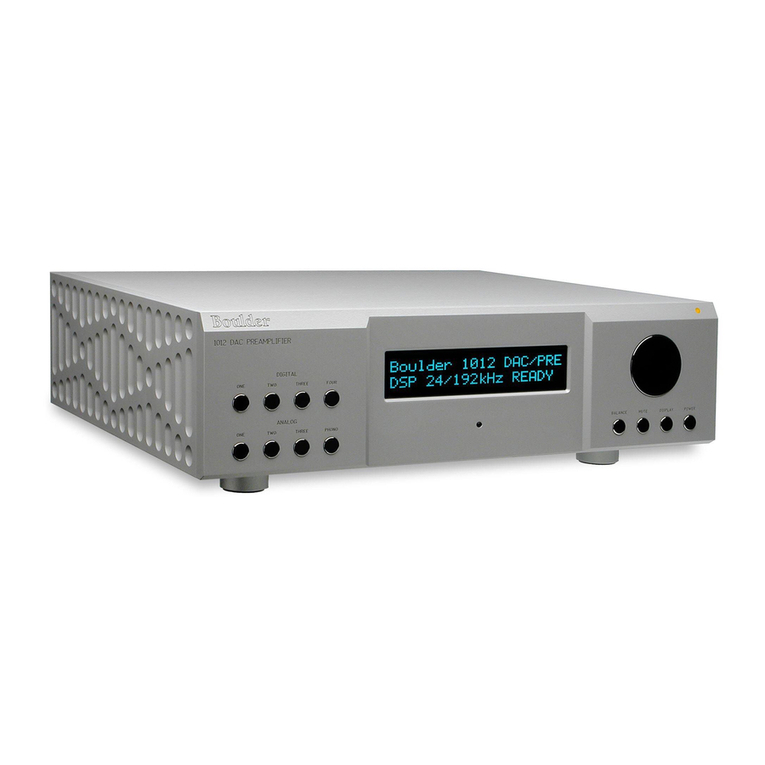
Boulder
Boulder 1012 DAC Preamplifier User manual
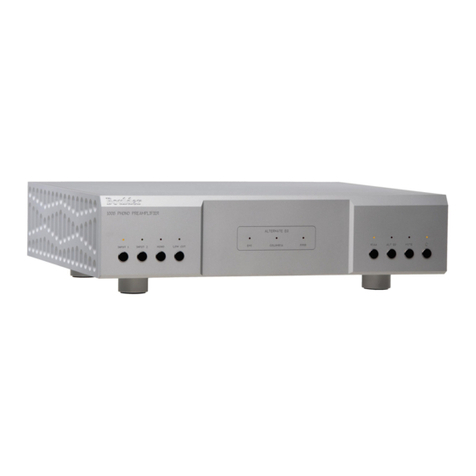
Boulder
Boulder 1008 User manual
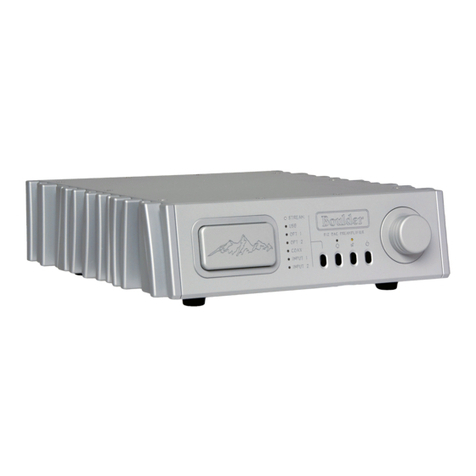
Boulder
Boulder 812 User manual
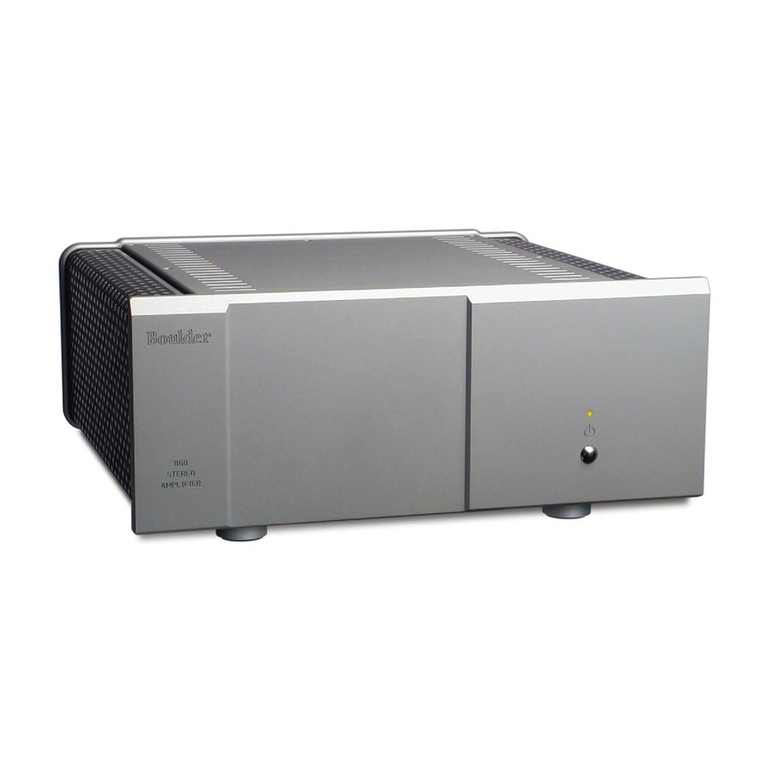
Boulder
Boulder 860 User manual

Boulder
Boulder 3060 User manual
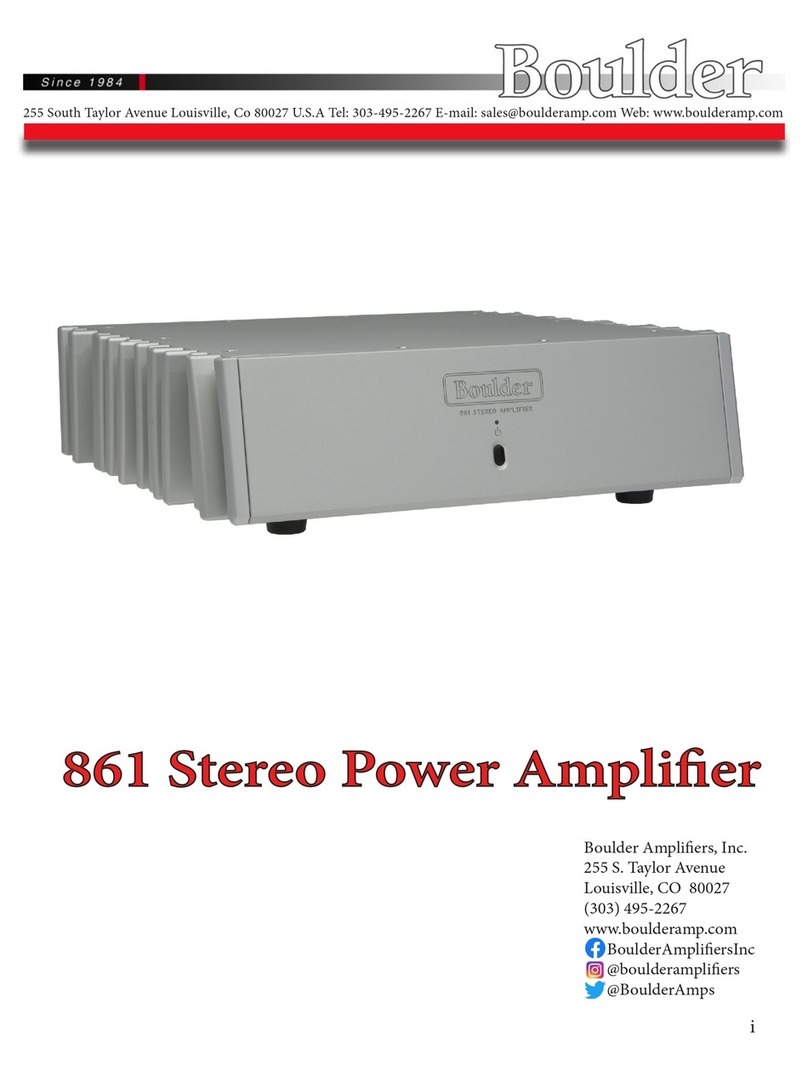
Boulder
Boulder 861 User manual
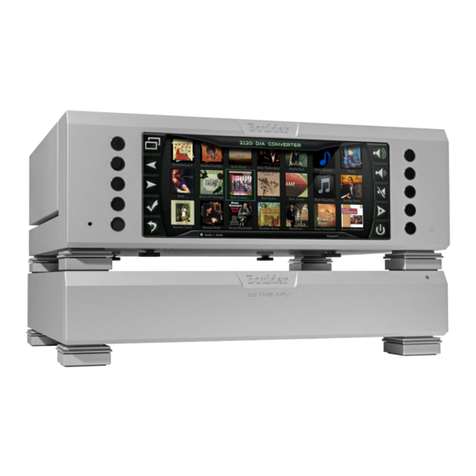
Boulder
Boulder 2120 User manual

